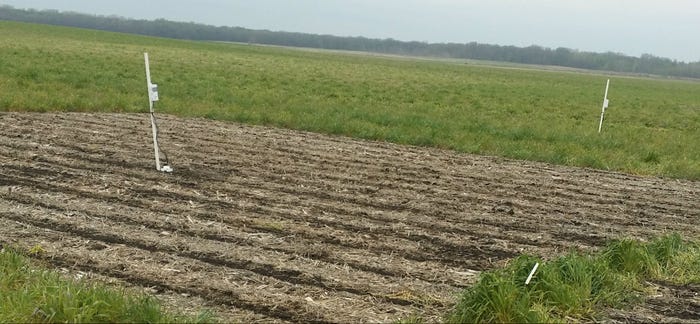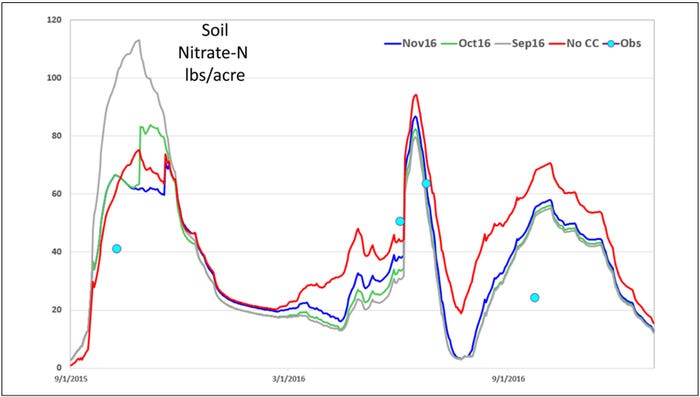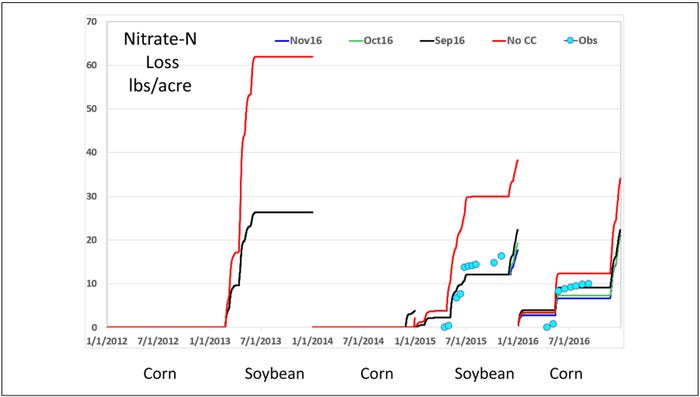June 2, 2017

By Theo Gunther, ISA Environmental Programs & Services; Peter Kyveryga, ISA Analytics; Sotirios Archontoulis, ISU Agronomy Department
Cover crops are one of the management practices that can be used to improve soil and water quality of Iowa cropping systems.
A joint project between the Iowa Soybean Association and Iowa State University is utilizing cropping systems modeling tools and observations from farmer fields to identify different scenarios in which cover crops can reduce the risk of nitrate loss. Specifically, can cover crops reduce the risk of nitrogen loss from early applications — September or October — of liquid swine manure?
Get more INSIGHT: Download Cover Crops: Best Management Practices now!
The Agricultural Production Systems sIMulator (APSIM) model was used to better understand the whole cropping system as well as its individual components such as nitrogen loss, organic matter mineralization and plant growth, and compare hypothetical alternative management scenarios.
Key results
The model simulations suggest that combining winter cover crop with fall manure can reduce the risk of nitrate loss through drainage tile. While in some years nitrate losses are small, over time the cover crop should help retain more nitrogen in manured systems and buffer the systems during wet years.
Setting up the trial
In September 2015, two control plots (60 x 60 feet) without cover crop were established within a no-till corn field planted to a winter rye in Eastern Iowa. Two plots with cover crops were established nearby in an area with the same topography and soil type. Soil temperature and moisture sensors were installed in each of the plots at 6, 12 and 18 inches deep (Fig 1) for year-around data collection.

Looking at the scenarios and results
The cropping systems model was calibrated to compare three manure application timing scenarios for soil nitrate and nitrate leaching potential.
The scenarios were:
September 16 hypothetical manure application with cover crop
October 16 hypothetical manure application with cover crop
November 16 actual manure application with cover crop (farmer practice)
November 16 hypothetical manure without cover crop

By mid-December, the farmer’s actual practice, a November 16 manure application with cover crops (blue line) had up to 60 lbs/acre nitrate in 12 inches of the soil (Figure 2). Based on the model simulations, by mid-December of 2015 the rates were as follows:
Nov 16 (red line): Up to 70 lbs/acre nitrate available
October 16 (green line): Up to 80 lbs/acre nitrate available
September 16 (gray line): Up to 110 lbs/acre nitrate available
The simulated amount of soil nitrate rapidly decreased during the winter, following a large rain event, before increasing again in early March (Figure 2). During the summer of 2016, the predicted soil nitrate stayed about 10-15 lbs/acre higher without cover crop (red line). By the spring, nitrate amounts did not differ for the various application timing with the rye crop.
The September 16 hypothetical swine manure applications in 2015 with cover crop would only slightly increase nitrate loss compared with those from November actual or October hypothetical applications with cover crops. The November 16 hypothetical applications without cover crop had a higher estimated nitrate loss, about 12 lbs/acre in 2016 and about 40 lbs/acre in 2015.

By mid-December, the farmer’s actual practice, a November 16 manure application with cover crops (blue line) had up to 60 lbs/acre nitrate in 12 inches of the soil (Figure 2). Based on the model simulations, by mid-December of 2015 the rates were as follows:
Nov 16 (red line): Up to 70 lbs/acre nitrate available
October 16 (green line): Up to 80 lbs/acre nitrate available
September 16 (gray line): Up to 110 lbs/acre nitrate available
The simulated amount of soil nitrate rapidly decreased during the winter, following a large rain event, before increasing again in early March (Figure 2). During the summer of 2016, the predicted soil nitrate stayed about 10-15 lbs/acre higher without cover crop (red line). By the spring, nitrate amounts did not differ for the various application timing with the rye crop.
The September 16 hypothetical swine manure applications in 2015 with cover crop would only slightly increase nitrate loss compared with those from November actual or October hypothetical applications with cover crops. The November 16 hypothetical applications without cover crop had a higher estimated nitrate loss, about 12 lbs/acre in 2016 and about 40 lbs/acre in 2015.
You May Also Like




